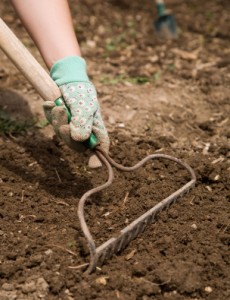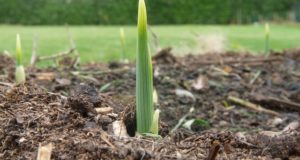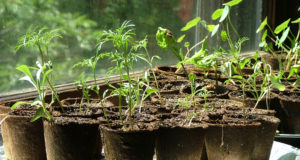While your garden is sleeping, it is preparing the foundation upon which your plants will be grown. However, there are still a few things you will need to do to help your garden along. Here is a list of chores that have to be completed while you wait for spring. I have them divided by month, but not necessarily in order of importance. Depending on your garden, you may not need or be able to do everything. So do what you are able, enjoy the preparation, relax, and bask in the promise of the coming spring.
March
 Plan your garden and make a list of tasks.
Plan your garden and make a list of tasks.- Read gardening books and catalogues – learn when to start seeds indoors.
- Pick up and bundle branches fallen from winter damage. Save some for plant supports.
- Cut back stalks and grasses.
- Pick up stones and set them aside for drainage solutions.
- Knock snow from branches, shrubs, and trees.
- Prune fruit trees and grape vines.
- Check for drainage problems.
- Feed bulbs – milk adds calcium and vitamin D.
- Build window boxes and containers.
- Take pictures of garden from two different angles for your journal.
- Re-pot indoor containers that need it.
- Buy seeds and test any left over from last year for germination.
- Order shrubs and plants from a good nursery.
- Clean out the shed and garage – discard damaged tools and clean and repair the others.
- Pot any leftover bulbs to force growth.
- Rake the lawn to clean, aerate, and stimulate growth.
- Plan needed lawn repairs for next month.
- Loosen leaves or mulch on bulbs and beds.
- Remove heavy mulch from beds with a pitchfork.
- Clean garden edges.
- Spread a light layer of compost on lawn.
- Add compost to flower beds and shrubs and aerate a bit with claw tool.
- Add lime to acidic soils.
- Water bulbs with some room temperature tea to stimulate growth.
- Turn over compost.
- Plant peas outside in mid-March, as weather permits.
- Start tomato plants.
- Spread gypsum along driveways, roadways, and pet areas.
- Prune trees and bushes that have sustained winter damage and to promote growth.
- Prepare garden beds for planting.
- Add leaves and mulch to compost pile.
New Survival Seed Bank™ Let’s You Plant A Full Acre Crisis Garden!
April
- Divide and transplant perennials.
- Clean flower beds.
- Build new beds.
- Add mulch everywhere to help retain moisture.
- Plant cold weather annuals.
April and May
- Take indoor plants outside in the shade during the daytime.
- Return plants to the warmth of the house at dusk.
- As the weather warms, late May into June, plants may stay outside all night – as long as all threat of frost is gone.
Starting Seeds Indoors
(Supplies needed: good planting medium, containers, good quality seeds, sunlight, and moisture.)
- Prepare soil – equal parts potting soil and compost.
- Fill three-inch pots with soil mixture.
- Set in a tray to catch water.
- Add a quart of water to tray and set overnight.
- Stagger plantings by a week or two so they are not all ready at once.
- Plant seeds – poke a hole in the soil and put in one to three seeds and cover lightly. Small seeds should only be an eighth to a quarter of an inch deep. Medium-sized seeds can be planted a quarter to a half inch deep. Large seeds can be up to one inch deep.
- Once seedlings are up, they will need sunlight and water. Set them in sunny area and lift the pots occasionally to determine need for water. If the pots feel light, add water to the trays.
Puzzled by pruning? Baffled by bulbs? Can’t tell a hosta from a hyacinth? Don’t worry!
Prepare Beds
If you fertilized and covered beds with mulch last fall, they won’t need much come planting time. Just loosen the soil with a fork or claw to prepare for planting. If you don’t have prepared beds, you may want to build some frames and fill them with good quality soil. A good size for beds will depend on your height and arm length. A taller person can reach across a four-foot square, while someone shorter can read across a three-foot square bed. This type of bed is easily covered with plastic in bad weather. (A mini greenhouse can even be built with chicken wire and heavy-duty plastic.) Tall plants can be covered with gallon milk jugs that have had their bottoms removed for protection from the weather. Have lots of mulch to put around plants to keep them safe from any late frosts.
If beds have not been prepared, it isn’t too late. Till soil twelve inches deep and mix in enough compost to bring the depth to eighteen inches. If it is too cold for planting, mulch well. If the winter is dry, water the bed once weekly to ensure a good harvest.
Making a Hotbed
A hotbed is raised bed built of two basic layers— a hot layer and a growing layer. The hot layer is the heat source for the bed. It contains a thick layer of manure and new compost. Start with a six-inch thick layer of straw. Add six to eight inches of manure and new compost, packing it down as you add. Lay in a layer of soil mixed with well-broken down compost for a growing layer. As the manure and compost break down below, they keep the bed warm for the young plants during the late winter and early spring. When the bed no longer gives off heat, you can use the bed for melons or other plants that require lots of fertilizer.
Preparing the Soil
The best blanket you can lay on your garden beds is the compost from your decaying piles. The next best is the molds growing in the leaves accumulated in your yard (but not oak leaves – they decay too slowly). These build your soil, adding good bacteria to it. They are best added in fall, but if you have left your compost and leaf piles to winter over, now is the time to put them to use; till them in, mixing well. Getting a package of nematodes from a garden supply may also add much-needed microbes to your beds. And you may need to make a visit to a bait shop or sporting goods store to pick up some worms. Raised beds don’t have these lively aerators in them unless you add them. For a bed that is four feet by eight feet, a single container is plenty. Larger beds will take more and smaller beds will need less.
By carefully planning and preparing your garden, you can lengthen its growing season and provide fresh, organic vegetables for your table practically year-round. Happy planning!
©2012 Off the Grid News
 Off The Grid News Better Ideas For Off The Grid Living
Off The Grid News Better Ideas For Off The Grid Living

 Plan your garden and make a list of tasks.
Plan your garden and make a list of tasks.


